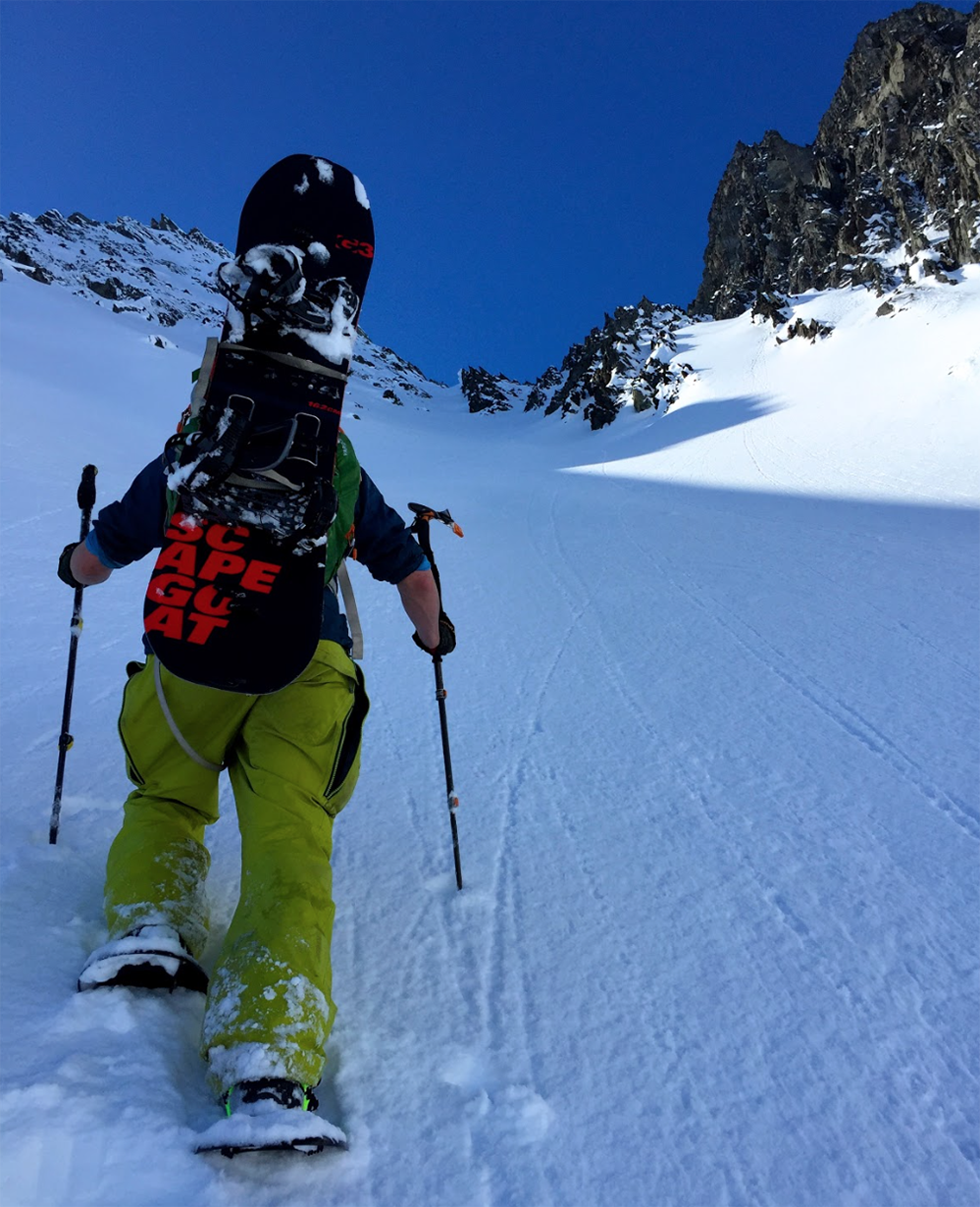Performance
It should be noted that this boot is designed for a very specific function: use in rugged mountains, where stiffness is desired. In my opinion, this is not a boot that would be very enjoyable at a resort, unless you’re racing — the extreme stiffness of the sole and spine of the boot makes for very rapid edging and power transfer. Perhaps I did not break them in enough, but I do not see this boot as ever being very playful for resort or freestyle-type riding.
That being said, the boot excels in big, backcountry terrain.
Touring
The Backcountry boot is one of the best boots I have ever used while in ski mode. The edging and lateral support is only matched by perhaps a hard, plastic AT boot. Edging on firm conditions while touring is significantly better than the Deeluxe Independent BC or any other snowboarding boot I have tried. I have built up so much trust in the ability to ski well in the boot, that I have used the Backcountry with the Karakoram Prime Carbons to speed-ride (skiing under a mini-paraglider). In addition, the added lateral support really helps to control the board in ski-mode on hardpack snow, which, in turn helps with touring on more exposed slopes with a heavy backpack.
While skinning, the stiffness of the boot does affect the “touring stride”. Modern splitboard bindings, such as the newer Karakoram and Spark R&D models, have an adjustment on the highback of the binding to allow a slacker highback angle, thus creating a longer and more comfortable stride when touring. I have noticed that the stiffness of the back of this boot does not function as well with the touring-stride setting, as opposed to a softer boot, such as the Independent BC.
Climbing
For serious ascents and scrambling, I’ve never used anything that compares to the Backcountry. The boot excels in crampons, Verts or simply booting up snow or rock. Although I have not attempted to climb water ice in these boots, I am sure that they would outperform any other snowboard boot, specifically any splitboard / backcountry-specific Deeluxe boot. I used the Deeluxe Independent BC numerous times on water ice and although they did work, the flex of the sole and enormous toe box inhibited the crampons from feeling solid and getting good purchase into the ice, problems that the Backcountry would alleviate.

The carbon shank along the sole of the boot allows for easy scrambling on loose talus and boulders, relieving fatigue on your calves and feet—similar to mountaineering boots.
Riding
Of course, one of the most critical aspects of any boot is how well it rides snowboarding. The Backcountry took a few days to get used to thanks to the impressive rigidity. The stiffness allowed for amazing edge transfer while riding at high speeds and on hardpack snow, but was quite different from the Independent BC or any other snowboard boot I have used.
When riding slide-for-life ice and lines with serious exposure, the boot can not be beat. However if you enjoy buttering and have a more playful approach to riding the lower mountain, the boot may feel too stiff. After 30+ days of use, the boot did not soften up much. This is a very desirable trait when riding the steeps or at high speeds, however it took me a while to get use to the rigidity when slashing turns and airing natural features. Perhaps I have not had enough time in the boot for the boot to soften up. I rarely used the top “Booster strap” since the boot felt so stiff for the first few rides, however if the boot does get softer and packs out, this strap will definitely help make up for that decline.
The Backcountry has a much smaller toe box and footprint than the Independent BC making it very compatible with all the bindings I have used, such as the Karakoram Prime Carbons and Spark R&D Blaze. Unless you are running your bindings on the smaller side, there should be no issue with fit. I am very impressed with how the rubber reinforcement protects against wear from the metal on the bindings along the heel cup.
Durability
The Backcountry seems to be one of the most durable boots I have come across. The entire build of the boot seems to prioritize durability and longevity. After 30+ days of use, including at least 15 days of snowmachine travel, there is no sign of abuse besides minor scuffing on the zebra-print rubber reinforcement along the toe box and heel. I could foresee this boot lasting at least several seasons ( 200+ days of use) with minimal damage.
Bottom Line
The Fitwell Backcountry is the boot for the serious backcountry adventurer. It performs better high in the alpine using crampons, Verts, or when climbing rock than any other snowboard boot I’ve used. It does seem to be a bit of a speciality boot, optimized for bold endeavors. If you prefer mellow powder runs and more freestyle-oriented riding, I would save some money and opt for something with more flex, like the Deeluxe Independent BC. However, if you have failed to find a stiff, high-performance boot that met your expectations for snowboard mountaineering in the past, the Fitwell Backcountry is perfectly suited to that kind of riding.

Super helpful review so thank you!
awesome review, helps me a lot!! Thanks!